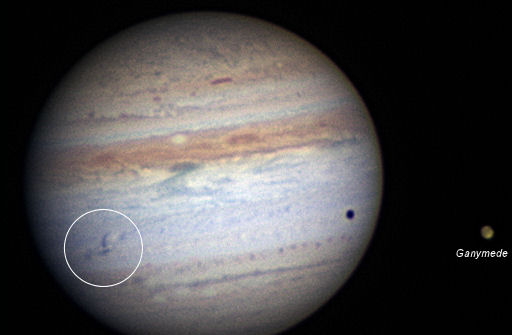Good Saturday, all! Today’s lecture has us looking at the changing face of Jupiter. The planet lost its southern equatorial belt in May, and now it appears to be returning.
REVIVAL ON JUPITER: Think of the turmoil at the sea surface just before a massive submarine emerges from depth. Something like that is happening on Jupiter. A turbulent plume is breaking through the giant planet’s cloudtops in the south equatorial zone, heralding the emergence of … what? Scroll past this Nov. 14th photo from astrophotographer Paul Haese of Glenalta, South Australia for further discussion:
The plume, circled in Haese’s photo and known to astronomers as the “SEB Revival Spot,” is a sign that Jupiter’s South Equatorial Belt (SEB) is about to return. The great brown belt disappeared earlier this year, leaving Jupiter without one of its signature stripes. No one knows where the SEB went, although some researchers have speculated that it sank beneath high altitude clouds and might now be bobbing back to the top.
Christopher Go of the Philippines first noticed the Revival Spot on Nov. 9th. At first it was small and white and required careful astrophotography to detect. Only five days later, it is expanding rapidly and darkening; soon, it could become visible to novices in the eyepieces of backyard telescopes. Stay tuned for updates.
more images: from Brian Combs of Buena Vista, GA; from John Nassr of Baguio, Philippines; from David Kolb of Lawrence, KS
Here is the story form May 2010 when the SEB disappeared.
May 20, 2010: In a development that has transformed the appearance of the solar system’s largest planet, one of Jupiter’s two main cloud belts has completely disappeared. (The link is to the entire article, please read the rest there):
“This is a big event,” says planetary scientist Glenn Orton of NASA’s Jet Propulsion Lab. “We’re monitoring the situation closely and do not yet fully understand what’s going on.”

Known as the South Equatorial Belt (SEB), the brown cloudy band is twice as wide as Earth and more than twenty times as long. The loss of such an enormous “stripe” can be seen with ease halfway across the solar system.
“In any size telescope, or even in large binoculars, Jupiter’s signature appearance has always included two broad equatorial belts,” says amateur astronomer Anthony Wesley of Australia. “I remember as a child seeing them through my small backyard refractor and it was unmistakable. Anyone who turns their telescope on Jupiter at the moment, however, will see a planet with only one belt–a very strange sight.”
Wesley is a veteran observer of Jupiter, famous for his discovery of a comet hitting the planet in 2009. Like many other astronomers, he noticed the belt fading late last year, “but I certainly didn’t expect to see it completely disappear,” he says. “Jupiter continues to surprise.”
Orton thinks the belt is not actually gone, but may be just hiding underneath some higher clouds.











